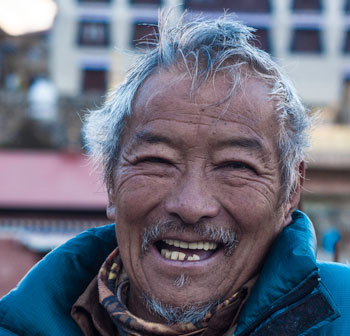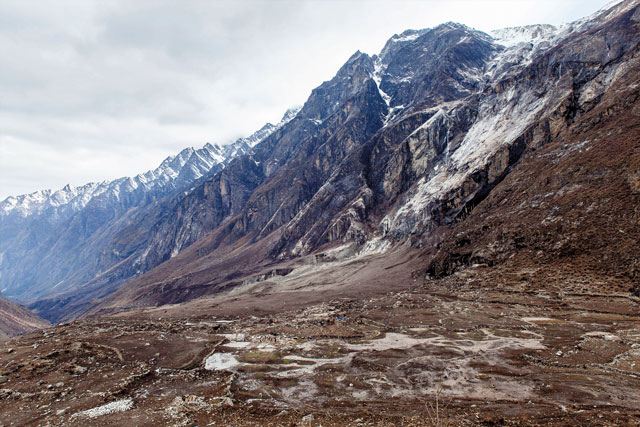Affectionately known as Paala, or father, 78 year old Pasang Thundup resides at the lodge he runs for visitors at Tengboche. With the animated disposition that comes to an inebriated man of age, Paala opened up about his life in the hidden valley one very cold morning.
 At 3,780 m, Tengboche spreads across a grassy flatland with dense orchards of rhododendron trees enveloping the freshly formed snow underneath it even during peak afternoons. The handful of lodges and even fewer homes give the Tengboche Monastery plenty of opportunity to stand out.
At 3,780 m, Tengboche spreads across a grassy flatland with dense orchards of rhododendron trees enveloping the freshly formed snow underneath it even during peak afternoons. The handful of lodges and even fewer homes give the Tengboche Monastery plenty of opportunity to stand out.
But before the Khumbu valley was opened for visitors, and before Tibet was occupied by China, 78-year-old Pasang Thundup and his brother Pasang went to Tibet for monastic education (the exact year he does not remember) like most people of the Khumbu valley at that time did.
Pasang’s elder brother went on to become the third abbot of Tengboche monastery, while Pasang got married after becoming a lama for 21 years. Today, Pasang owns a rather charming lodge at Tengboche called Tashi Delek.
Have you been living in Tengboche your whole life?
The abbot of the monastery is my big brother. We went to Tibet for studies together and stayed there for 18 years. It was only after the Chinese invasion that we came back here.

So all this was before the Chinese occupation of Tibet? Do you know which year?
Yeah! I don’t know the exact date, but most people from the Khumbu valley used to go to Tibet looking for opportunities. It used to be only small trade, and we mostly exchanged goods. It was not only Tibet; people from the region used to go to Kalimpong, Gangtok, and Darjeeling, while some went further down till Calcutta. There was no formal education then, like there is today. The journey was made mainly for monastic education. After the invasion, all of us from the valley came back. Times were different then. There were no tourists. We used to survive on potato pancakes and dhindo.
Yeah. There’s a lot of potato around.
(Laughs) This diet is the main reason that I am still healthy today. I am seventy-eight. People now hardly live for 45-55 years.
What is the first memory you have of the monastery here at Tengboche?
I have a faint memory of the elder lamas recalling the earthquake of 1990 B.S. The head priest died in the earthquake. Then, the second abbot replaced him, and now the third abbot is my elder brother.
What is the significance of the monastery to the people of this region?
They say that the monastery and its abbot are the guardian of the people of the region. It is one of the most important religious sites in the district of Solukhumbu.
How many lamas are there in the monastery now? Does it hold significance for the lamas to come and study here?
Of course getting educated here is a big deal. But I don’t understand the lamas these days. They come and then leave the monastery altogether for other opportunities. Maybe beautiful girls are the reason (laughs). Things were different during my days. Now there are hardly 27 lamas; there were 45 lamas just two years ago.
You have been living here most of your lifetime. What changes have you seen in and around?
I can only cry now. People are getting educated and money-minded, and have less time to comprehend and acknowledge their surroundings. That is the reason we had the recent earthquake. If you are situated firmly within yourself, then prosperity will come. Why hurry?
The mountains have turned dark as the snow melts. Earlier, they used to be pristine and white. Even the forests have turned thin.
I saw Ama Dablam yesterday for the first time during the sunset. It was covered with mist, and only the peak was visible. It is still beautiful today. I can only imagine how it was like during your days.
I know the feeling. It is blissful just being in the presence of these mountains, if you understand its significance, that is.










